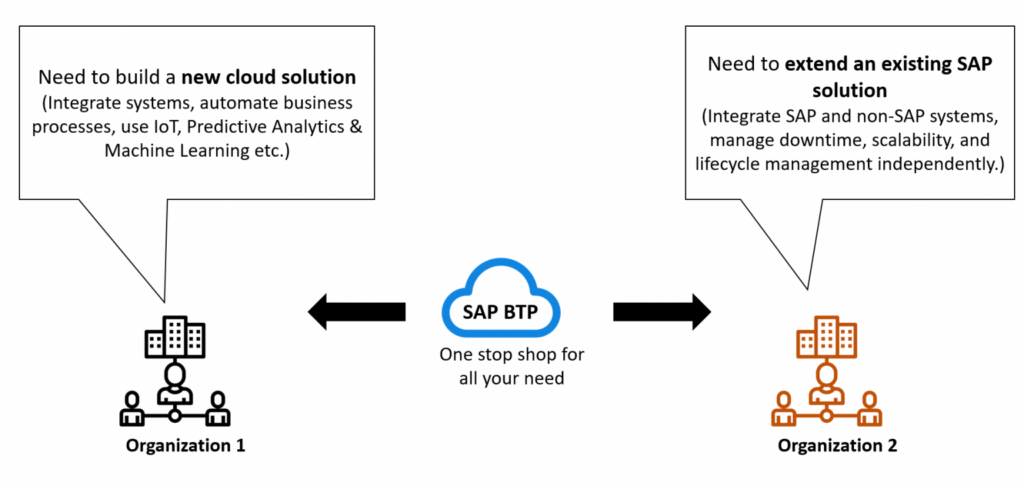Prior to the year 2020, SAP had several other platforms that were used for application development, data management, and integration. Such as:
- SAP HANA Cloud Platform (HCP) – A cloud-based platform that provides tools and services for developing and deploying SAP HANA-based applications.
- SAP Cloud Platform Integration (CPI) – A cloud-based integration platform that allows businesses to integrate SAP and non-SAP systems and applications.
- SAP Cloud Platform Mobile Services – A platform for building and deploying mobile applications that are integrated with SAP systems.
- SAP Cloud Platform Internet of Things (IoT) – A platform for connecting IoT devices and sensors to SAP systems and applications.
In 2020, SAP introduced a unified platform by rebranding and consolidating several technologies, including HCP, CPI, and the mobile and IoT platforms. This new platform was named SAP Business Technology Platform (BTP).
By integrating these technologies under the SAP BTP umbrella, SAP aims to provide a more streamlined and cohesive experience for its customers, while embracing the latest advancements in cloud technologies and trends.
In this blog, we will explore how the SAP Business Technology Platform (BTP) can help businesses accelerate their digital transformation efforts.
Let’s understand SAP BTP
Consider the two scenarios given below:
Scenario 1
Whether you’re an existing SAP client or new to the SAP ecosystem, consider an organization wanting to create a cloud or mobile solution. This solution requires connecting multiple systems, streamlining complex business operations, and integrating modern technologies such as the Internet of Things (IoT), Predictive Analytics, and Machine Learning.
Scenario 2
Imagine an organization, whether an existing SAP customer or not, aiming to develop a cloud-based solution to enhance its current SAP systems, such as S/4HANA or SuccessFactors. They need services to ensure smooth operation between systems and applications, managing downtime, scalability, and lifecycle management independently.
Learn More – RISE with SAP for S/4HANA — Is It A Good Option for You?
Common Goals
In both scenarios, the objective is to build solutions that are effortless, cost-effective, and time-efficient. Organizations seek to avoid spending excessive time and resources on landscape setup, system configuration, and maintenance. SAP BTP enables them to achieve these goals by providing a comprehensive platform that simplifies and accelerates the development and integration of cloud-based solutions.

Source: https://blogs.sap.com/
The Five Pillars of SAP BTP
SAP BTP is built on five key technology portfolios, each offering a unique set of capabilities to support various aspects of digital transformation:
1. Application Development and Automation
SAP BTP’s application development capabilities enable organizations to create cloud applications customized to their specific business needs, catering to a range of development skills from Low Code/No Code (LCNC) to Pro Code.
Low Code/No Code (LCNC): Empowers non-technical users to develop applications.
- SAP Build Apps: Allows the creation of enterprise applications without the need for coding.
- SAP Build Process Automation: Simplifies the automation of workflows and tasks using drag-and-drop functionality.
- SAP Build Work Zone: Facilitates the design of interactive business sites for efficient task execution across enterprise applications.
Pro Code: Tailored for experienced developers.
- ABAP Environment: Enables the use of ABAP to develop and run applications in the cloud.
- SAP Business Application Studio: Provides an integrated development environment (IDE) that enhances productivity with tools for Java, JavaScript (Node.js), and SAP Fiori.
- Cloud Native: Supports the creation of scalable, resilient, and manageable applications.
SAP BTP also emphasizes automation to streamline routine tasks, allowing employees to focus on high-value activities that drive growth. The main automation offering is SAP Build Process Automation, which enhances efficiency and productivity.
Learn More – Stay Ahead of the Competition with SAP HANA Smart Data Integration: Here’s How
It integrates Workflow Management to automate workflows across different SAP applications, and Business Rules to implement rule-based decision-making. Robotic Process Automation (RPA) creates intelligent bots to handle repetitive tasks, while the Task Center centralizes tasks from various SAP applications, such as leave requests in SuccessFactors and expense reports in Concur, improving overall productivity.
2. Data & Analytics:
Maximizing the value of data is a key priority for organizations. SAP BTP Data & Analytics allows businesses to work with their data, integrating it with non-application data to facilitate comprehensive planning and decision-making across the organization.
- SAP HANA Cloud: Serving as the core of the data management layer, SAP HANA Cloud is a modern database-as-a-service with powerful in-memory capabilities, capable of handling both structured and unstructured data.
- Data Management and Data Warehouse: Built on SAP HANA Cloud, these capabilities enable users to extract, process, and analyze data from various sources.
- SAP Analytics Cloud (SAC): An all-in-one cloud solution offered as software as a service (SaaS) for business intelligence, planning, and predictive analytics. Natively built on SAP BTP, SAC provides a unified, secure cloud experience, enhancing data-driven decision-making.
3. Integration
The SAP BTP Integration Suite offers a comprehensive platform-as-a-service (PaaS) designed to integrate business processes seamlessly using advanced tools and pre-built integrations from both SAP and third-party providers. This suite supports various integration scenarios, including Application to Application (A2A), Business to Business (B2B), Business to Government (B2G), event-based integrations, and extract-transform-load (ETL) processes.
- Cloud Integration: Acts as an enterprise-grade middleware, providing numerous out-of-the-box integration options and protocols to facilitate rapid and effective system and application integrations.
- API Management: Manages the entire lifecycle of APIs, enhancing security with pre-defined policies and offering centralized monitoring capabilities.
- Event Mesh: Allows applications to communicate asynchronously and in real-time, ensuring reliable and scalable data exchange through event brokers.
- Integration Advisor: Utilizes a community-driven repository to accelerate mapping processes in integration scenarios.
- OpenConnectors: Provides pre-built connectors for popular applications like SharePoint, email servers, social networks, and CRMs, streamlining the integration setup.
- Integration Assessment: Offers a framework to speed up the design of hybrid integration platforms, ensuring projects adhere to SAP best practices and fostering an agile integration culture within the organization.
Learn More – Stay Ahead of the Competition with SAP HANA Smart Data Integration: Here’s How
4. Artificial Intelligence
SAP BTP infuses intelligence into business processes by embedding AI capabilities directly into SAP applications, automating, optimizing, and reimagining these processes across various business lines.
- SAP AI Core and SAP AI Launchpad: These services help manage, deploy, and integrate custom AI modules within SAP applications, enabling businesses to leverage AI for enhanced decision-making and operational efficiency.
- Embedded AI Services: These capabilities allow for the seamless integration of AI into business processes, enhancing tasks such as demand forecasting, customer service automation, and anomaly detection.
5. Extended planning and analysis (xP&A)
Extended Planning and Analysis (xP&A) addresses the limitations of traditional financial planning and analysis (FP&A). By unifying strategic, financial, and operational planning, xP&A provides a single source of truth for data, promoting collaboration and improving decision-making.
- Unified Planning: xP&A integrates planning processes across strategic, financial, and operational domains, creating a cohesive and comprehensive planning framework.
- Enhanced Agility: By adopting xP&A, businesses can become more agile and adaptable, improving their decision-making and overall performance.
- Innovative Tools: The transition to xP&A is facilitated by advanced products like SAP S/4HANA and SAP Analytics Cloud, ensuring a smooth and effective shift to this integrated planning approach.
Benefits of SAP Business Technology Platform
Adopting SAP BTP offers numerous benefits that can accelerate digital transformation and drive innovation:
-
Agility and Flexibility:
SAP BTP enables businesses to quickly adapt to changing market conditions and scale their applications and infrastructure as needed. With a choice of cloud infrastructure providers like Amazon Web Services (AWS), Microsoft Azure, Google Cloud, and Alibaba Cloud, organizations can select the environment that best meets their needs, supported by a multi-cloud foundation.
-
Integration and Connectivity:
SAP BTP provides robust integration capabilities through the SAP Integration Suite, featuring over 2,000 prebuilt integrations and numerous connectors. This ensures seamless connectivity between SAP and non-SAP applications, automating business processes and enhancing data consistency across the enterprise.
-
Innovation and Customization:
The Extension Suite enables organizations to innovate and customize SAP applications to meet unique business needs. Businesses can develop custom applications and extend existing ones like SAP S/4HANA and SuccessFactors using low-code/no-code tools such as SAP AppGyver and SAP Business Application Studio.
-
Enhanced Data Insights:
The Analytics portfolio allows businesses to extract and leverage valuable insights from their data with tools like SAP Analytics Cloud and SAP BusinessObjects Business Intelligence suite. This supports real-time data visualization, analysis, and reporting, enabling data-driven decision-making and operational efficiency.
-
Future-readiness:
By integrating intelligent technologies such as AI, ML, IoT, and blockchain, SAP BTP ensures that organizations are prepared for future technological advancements. These technologies enable automation, predictive analytics, and innovative solutions, helping businesses stay ahead of market trends and adapt to new demands. SAP BTP equips organizations with the tools needed to drive continuous innovation and remain competitive in the digital age.
Learn More – Usage and Features of SAP S/4HANA that can make Retail Management Easier
-
Product Extensibility:
SAP BTP promotes product extensibility, allowing organizations to implement S/4HANA Core with standard functionality and avoid customization within the core system. Instead, businesses can bring customizations and enhancements into SAP BTP, keeping the core system clean while still meeting their specific business requirements. This approach enhances flexibility and agility, enabling organizations to adapt to evolving business needs without compromising the integrity of the core system.
SAP BTP for Your Business
SAP BTP stands out as a robust technology platform for SAP ERP customers, offering an extensive array of services that seamlessly integrate with business processes, SAP data, and third-party data sources. This platform empowers businesses to foster innovation, accelerate digital transformation, and achieve greater success.
To explore how SAP BTP can revolutionize your business, connect with one of our SAP experts today.


